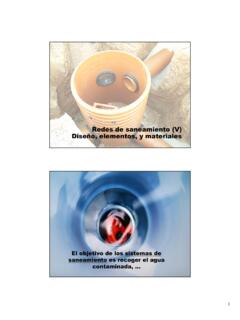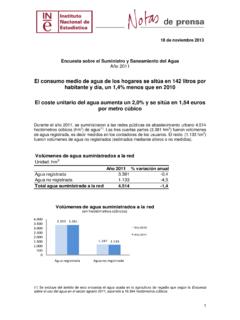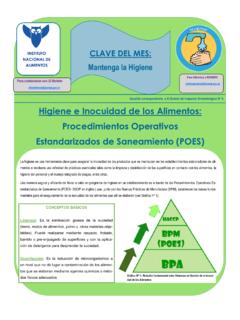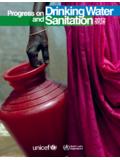Transcription of COMMUNITY APPROACHES to TOTAL SANITATION
1 1case study COMMUNITY APPROACHES to TOTAL SANITATIONlBased on case studies from India, Nepal, Sierra Leone, Zambia Field Notes: unicef Policy and Programming in PracticeCOMMUNITY APPROACHES to TOTAL SANITATIOND ivision of Policy and PracticeProgramme DivisionPublicationField Notes united Nations children s Fund ( unicef ), New york, 2009cover photo unicef sierra LeoneField Notes is an evidence-based divisional publication series, documenting good practices in innovative unicef program-ming, policy and operations. each Field Note focuses on one theme, contextualizing the topic within a discussion of major issues, illustrating implementation in the field through case studies, and identifying good practices to inform unicef staff and our partners. Field Notes are produced by unicef s division of Policy and Practice in collaboration with unicef technical sections and country offices where programming is being undertaken.
2 The editors of the series are Ian thorpe and david stewart of the Policy, advocacy and Knowledge Management section. the designations in this Field Note do not imply an opinion of legal status of any country or territory, or of its authorities, or the delineation of frontiers. While Field Notes outline unicef s approach to programming and policy, statements in this document do not imply or constitute official opinions or policy positions of either the united Nations or Field Note was prepared by: colleen Galbraith (Policy, advocacy and Knowledge Management) and ann thomas (Water, SANITATION and Hygiene), and produced by unicef s division of Policy and data, information and materials were contributed by: therese dooley and Peter VanMaanen (WasH, NyHQ), alka Malho-tra, (India), Namaste shrestha (Nepal) Victor Vincent Kinyanjui, arnold cole and emily Bamford (sierra Leone), Peter Harvey and Leonard Mukosha (Zambia).
3 Design support from upasana young, copy editing catherine further information on Field Notes, please contact:Policy, advocacy and Knowledge Management, division of Policy and Practiceunited Nations children s Fund3 united Nations Plaza New york, Ny 10017, usaemail: study CONTENTSE xecutive Summary Thematic Overview | COMMUNITY APPROACHES to TOTAL SANITATION (cats) Sierra Leone | communities Lead the Way to Improved SANITATION in a Post-conflict country Zambia | engaging Local Leadership for TOTAL sanitationIndia | the TOTAL SANITATION campaignNepal | the Power of children as catalysts for changeReferences 461116202227 Based on case studies from India, Nepal, Sierra Leone and Zambia COMMUNITY APPROACHES to TOTAL SANITATION4executIVe suMMaRyExECUTIvE SUMMARY COMMUNITY APPROACHES to TOTAL SANITATION (cats) is anumbrella term used by unicef SANITATION practitioners to en-compass a wide range of COMMUNITY -based SANITATION program-ming.
4 Cats share the goal of eliminating open defecation; they are rooted in COMMUNITY demand and leadership, focused on behaviour and social change, and committed to local innovation. the cats essential elements are a framework for action, pro-viding a common foundation for work in the sector while allow-ing for broad variation in the way programmes are applied and translated locally. unicef works closely with governments and other partners in more than 50 countries around the world to mainstream cats and bring SANITATION programming to scale. the essential ele-ments are based on lessons learned from decades of SANITATION programming and reflect unicef s Global strategy for water, SANITATION and hygiene (WasH). Worldwide application of cats has the potential to bring the Millennium development Goal SANITATION target to halve, by 2015, the proportion of the popu-lation without sustainable access to safe drinking water and basic SANITATION within reach by transforming the global rate of progress in SANITATION .
5 This Field Note discusses the evolution of SANITATION program-ming in unicef and the origins of our COMMUNITY APPROACHES to TOTAL SANITATION . It examines each of the cats essential ele-ments and explores their implementation through country case studies. the case studies illustrate a range of methods under the cats umbrella: COMMUNITY -Led TOTAL SANITATION (cLts) in sierra Leone and Zambia; school-Led TOTAL SANITATION (sLts) in Nepal; and the TOTAL SANITATION campaign (tsc) in India. these are only a few of the many COMMUNITY APPROACHES to TOTAL SANITATION being under-taken around the world that exemplify the cats essential elements. uNI ceF supports COMMUNITY APPROACHES to TOTAL sanita-tion (cats) with the goal of eliminating open defecation in communities around the world.
6 The cats essential elements are the common foundation for unicef sani-tation programming globally. these principles provide a framework for action and a set of shared values that can be easily adapted for programming in diverse contexts. at their core, cats rely on COMMUNITY mobiliza-tion and behaviour change to improve SANITATION and integrate hygiene practices. they are demand-driven and COMMUNITY -led, and empha-size the sustainable use of safe, affordable, user-friendly SANITATION APPROACHES to TOTAL Sanitation5cats esseNtIaL eLeMeNts The Essential Elements of COMMUNITY APPROACHES to TOTAL SANITATION (CATS) the cats essential elements are the common foundation for unicef SANITATION programming globally. they provide a framework for action that can be easily adapted for programming in diverse contexts.
7 1 CATS aim to achieve 100 per cent open defecation free (ODF) communities through affordable, ap-propriate technology and behaviour change. The emphasis of CATS is the sustainable use of sanita-tion facilities rather than the construction of infrastructure. The safe disposal of infant and young children s faeces in toilets is essential to achieving ODF status. 2 CATS depend on broad engagement with diverse members of the COMMUNITY , including house-holds, schools, health centres and traditional leadership structures. 3 Communities lead the change process and use their own capacities to attain their objectives. Their role is central in planning and implementing improved SANITATION , taking into account the needs of diverse COMMUNITY members, including vulnerable groups, people with disabilities, and women and Subsidies whether funds, hardware or other forms should not be given directly to households.
8 COMMUNITY rewards, subsidies and incentives are acceptable only where they encourage collec-tive action in support of TOTAL SANITATION and where they facilitate the sustainable use of SANITATION facilities. 5 CATS support communities to determine for themselves what design and materials work best for sani-tation infrastructure rather than imposing standards. External agencies provide guidance rather than regulation. Thus, households build toilets based on locally available materials using the skills of local technicians and artisans. 6 CATS focus on building local capacities to enable sustainability. This includes the training of com-munity facilitators and local artisans, and the encouragement of local champions for COMMUNITY -led programmes. 7 Government participation from the outset at the local and national levels ensures the effective-ness of CATS and the potential for scaling up.
9 8 CATS have the greatest impact when they integrate hygiene promotion into programme design. The definition, scope and sequencing of hygiene components should always be based on the local CATS are an entry point for social change and a potential catalyst for wider COMMUNITY CATS Essential Elements were articulated by unicef SANITATION specialists in July 2008 as the non-negotiable aspects of COMMUNITY -based SANITATION oVeRVIeWISSUE Around the world, poor SANITATION remains a major threat to develop-ment, impacting countries progress in health, education, gender equity, and social and economic develop-ment. Globally, billion people in-cluding 840 million children do not use improved SANITATION ; billion, almost a fifth of the world s population, practise open defecation.
10 In rural areas, this is the case for nearly 1 in 3 share of open defecators by country, in millions open defecation and its public health social and economic impacts, can create a vicious cycle of illness, high expen-diture on health care, lost work and school hours, and SANITATION and hygiene, highest cost for women and children. Wo m-en, adolescent girls, children and infants suffer most from inadequate hygiene and SANITATION facilities. the two main causes of mortality among children under age five acute respiratory infections and diarrhoeal diseases are closely linked to poor water, hygiene and SANITATION . of the million people estimated to die each year from diarrhoea, million are Repeated diarrhoeal episodes are a significant underlying cause of malnutrition, leading to weakened im-mune systems and impaired growth and Girls and women are made more vulnerable by poor SANITATION and hygiene.















